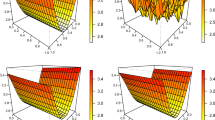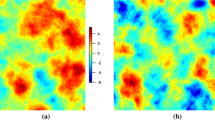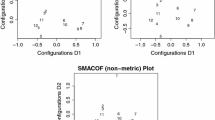Abstract
Conventional geostatistics often relies on the assumption of second order stationarity of the random function (RF). Generally, local means and local variances of the random variables (RVs) are assumed to be constant throughout the domain. Large scale differences in the local means and local variances of the RVs are referred to as trends. Two problems of building geostatistical models in presence of mean trends are: (1) inflation of the conditional variances and (2) the spatial continuity is exaggerated. Variance trends on the other hand cause conditional variances to be over-estimated in certain regions of the domain and under-estimated in other areas. In both cases the uncertainty characterized by the geostatistical model is improperly assessed. This paper proposes a new approach to identify the presence and contribution of mean and variance trends in the domain via calculation of the experimental semivariogram. The traditional experimental semivariogram expression is decomposed into three components: (1) the mean trend, (2) the variance trend and (3) the stationary component. Under stationary conditions, both the mean and the variance trend components should be close to zero. This proposed approach is intended to be used in the early stages of data analysis when domains are being defined or to verify the impact of detrending techniques in the conditioning dataset for validating domains. This approach determines the source of a trend, thereby facilitating the choice of a suitable detrending method for effective resource modeling.













Similar content being viewed by others
References
Chilès JP, Delfiner P (1999) Geostatistics, modeling spatial uncertainty. Wiley-Interscience, New York
Costa JF (2009) Interpolating datasets with trends: a modified median Polish approach. Comput Geosci 35(11):2222–2230
Cressie N (1985) When are relative variograms useful in geostatistics? Math Geol 17(7):693–702
David M (1977) Geostatistical ore reserve estimation. Elsevier Scientific Publishing Company, Amsterdam
Davis M, David M (1978) Automatic kriging and contouring in the presence of trends (universal kriging made simple). J Can Pet Technol 17(1):90–99
Demyanov V, Soltani S, Kanevski M, Canu S, Maignan M, Savelieva E, Timonin V, Pisarenko V (2001) Wavelet analysis residual kriging vs. neural network residual kriging. Stoch Environ Res Risk Assess 15(1):18–32
Deutsch CV (2002) Geostatistical reservoir modeling. Oxford University Press, New York
Deutsch CV, Journel A (1997) GsLib: geostatistical software library and user’s guide. Oxford University Press, New York
Gneiting T, Sasvári Z, Schlater M (2001) Analogies and correspondences between variograms and covariance functions. Appl Probab 33(3):617–630
Goovaerts P (1997) Geostatistics for natural resources evaluation. Oxford University Press, New York
Gringarten E, Deutsch CV (2001) Teacher’s aide—variogram interpretation and modeling. Math Geol 33(4):507–534
Isaaks EH, Srivastava MR (1989) An introduction to applied geostatistics. Oxford University Press, New York
Journel A, Huijbregts CJ (1978) Mining geostatistics. Academic Press, London
Journel AG, Rossi ME (1989) When do we need a trend model in kriging. Math Geol 21(7):715–739
Kanevski M, Arutyunyan R, Bolshov L, Demyanov V, Maignan M (1996) Artificial neural networks and spatial estimations of Chernobyl fallout. Geoinformatics 7(1–2):5–11
Larrondo P, Deutsch CV (2004) Accounting for geological boundaries in geostatistical modeling of multiple rock types. In: Leuangthong O, Deutsch CV (eds) Geostatistics Banff 2004. Springer, Dordrecht, pp 3–12
Leuangthong O, Deutsch CV (2004) Transformation of residuals to avoid artifacts in geostatistical modelling with a trend. Math Geol 36(3):287–305
Leuangthong O, Khan D, Deutsch CV (2008) Solved problems in geostatistics. Wiley-Interscience, Hoboken
Manchuck JG, Leuangthong O, Deutsch CV (2009) The proportional effect. Math Geosci 41(7):799–816
Matheron G (1962) Traité de Géostatistique Appliquée. Technip, Paris
Matheron G (1969) Le krigeage universel. Les Cahiers du Centre de Morphologie Math. Fasc. 1, Ed. CG. Fontainebleau. http://cg.ensmp.fr/bibliotheque/public/MATHERON_Ouvrage_00131.pdf
McLennan JA (2007) The decision of stationarity. Dissertation, University of Alberta, Edmonton
Myers DE (1989) To be or not to be… stationary? That is the question. Math Geol 21(3):347–362
Neuman SP, Jacobson EA (1984) Analysis of nonintrinsic spatial variability by residual kriging with application to regional groundwater levels. Math Geol 16(5):499–521
Olea RA (1974) Optimal contour mapping using universal kriging. J Geophys Res 79(5):695–702
Olea RA (1991) Geostatistical glossary and multilingual dictionary. Oxford University Press, New York
Olea RA (2006) A six-step practical approach to semivariogram modelling. Stoch Environ Res Risk Assess 20(5):307–318
Author information
Authors and Affiliations
Corresponding author
Rights and permissions
About this article
Cite this article
Cuba, M.A., Leuangthong, O. & Ortiz, J.M. Detecting and quantifying sources of non-stationarity via experimental semivariogram modeling. Stoch Environ Res Risk Assess 26, 247–260 (2012). https://doi.org/10.1007/s00477-011-0501-9
Published:
Issue Date:
DOI: https://doi.org/10.1007/s00477-011-0501-9




